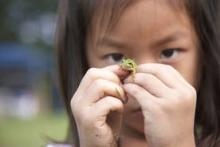It’s been a quiet week in the world of pop culture. How quiet? Let’s just say that major news on Yahoo’s “OMG!” celebrity page included the fact that Anne Hathaway...wait for it...kissed her husband Adam Shulman when they went out for coffee in Brooklyn. Oh. My. Gosh (or whatever)! In other news, we learn that Maddox Jolie-Pitt (or whatever) is growing and developing normally and that, while no one has any clue when and how Jennifer Aniston and fiancé Justin Theroux are getting married, one celebrity wedding expert thinks Aniston will probably make this wedding different than her first. So help me, if some pop star doesn’t crash a Ferrari full of shoplifted lingerie while speeding to rehab with an unrestrained love child in the front seat in the next 7 days, the next “Needles” is going to open with politics.
Metal head
Anyone who knows me will tell you that I love, love, love evidence-based medicine! How much do I love it? Let’s just say that I may be legally required to always remain at least 100 yards from the Cochrane Collaboration. But some days, even I have to admit that I get frustrated at how little we actually know about what works, even when it should be obvious. Like, say you discover a 3-year-old patient has iron deficiency anemia. So you give him a daily iron supplement, right? Right?!
Who knows? The most recent trip down the evidence-based rabbit hole suggests that we don’t even know if giving children iron fixes iron deficiency, corrects iron deficiency anemia (because naturally they’re two different things) or improves cognitive deficits resulting from low iron. That’s after a group of Australian researchers (why is it always the Australians?) combed through 9,169 papers on the topic and identified a whole 15 studies that met their inclusion criteria, all of which were still considered at moderate risk of statistical bias. Where are our scientific priorities? How is it we can perfect the Blooming Onion, but we can’t run a basic study of whether we should give iron-deficient kids iron?
The results of the meta-analysis just get more confusing. Daily iron supplementation in 2- to 5-year-olds does seem to increase blood levels of hemoglobin and ferritin, but those results alone are not adequate to say that such end points as anemia, iron deficiency, and iron deficiency anemia are actually better, although some evidence might suggest improved cognition. At least iron supplementation did not appear to increase kids’ risk of getting respiratory infections and diarrhea (because why would it?). For now I’m going to continue to put my right shoe on my right foot, at least until the Australian meta-analyze that, too.
Thought for food
Speaking of stuff we thought we knew, you remember how just a few years ago, we were warning parents that if their kids even looked at a shrimp or an egg before age 2 they would develop life-threatening food allergies? Ha, parents! You didn’t think we were serious, did you? Nah, pediatricians and allergists are just a bunch of jokesters! What we meant to say was that the earlier you expose your children to potentially allergenic foods, the better! Wean them straight to pureed prawns with Thai peanut sauce at 4-6 months of age unless you want to have to buy big economy packs of epinephrine auto-injectors. Oh, and that “Kick Me” sign on your back? That was us, too.
That’s right, the American Academy of Allergy and Immunology (AAAAI) has released a new policy statement that nearly completes our about-face on avoiding food allergies in children. Except for a little hedging about maybe starting with a few bites of less-allergenic first foods, they now say that if you have a blender that can handle crab cake eggs Benedict with soy-glazed shishito peppers, you can spoon-feed them to your 6-month old. There are still some exceptions in the guidelines. If patients have had an allergic reaction to a food, difficult-to-control moderate-to-severe atopic dermatitis, or an underlying food allergy, you should either refer them to an allergist or give them one of your feeding handouts from 2010.
A small pond
There is pretty much nothing cuter than those little African dwarf frogs they sell by the cash register at high-end toys stores, except maybe Maddox Jolie-Pitt (or whatever) before he grew all big and hairy. I’ve always just barely resisted the temptation to bring one home (a frog, not one of Brangelina’s children). That was before I knew they could live as long as 18 years (again, the frogs). Now I’m relieved, not only because the last frog we had got eaten by the cat, but also because my children will have to get their salmonella from something normal, like cantaloupe.
Investigators at the Centers For Disease Control and Prevention (CDC) tracked 376 cases of salmonella enteritis back to a single distributor of the amphibians, located in Madera County, California. The facility shut down for disinfection in 2011, and now they’re clean, but remember how long those little web-footed suckers live? That’s right, some of these kids who got frogs for Christmas probably won’t develop salmonella until they’re in graduate school. Hopefully, by then there will be some interesting celebrity gossip, or at least Jennifer Aniston will have finally gotten remarried.


